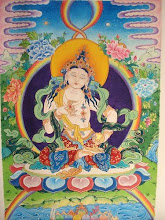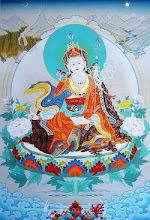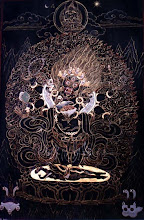Monday, June 25, 2007
Not much seems to have changed
Severn Cullis-Suzuki, 12 years old,
at the 1992 UN Earth Summit Rio.
Amazing.
Sunday, June 24, 2007
Pure Land Lecture at Nishi-Hongwanji


Reverend Sammi Kiribayashi, Chief Administrator of Fukuoka City’s Nishi-Hongwanji and former Minister at Vancouver Buddhist Church, spoke for 30 minutes on the basic tenets of Jodo Shinshu Buddhism, presented a short sutra reading, and followed with a 30-minute question and answer session. Following the formal end of the day’s program, there was still much to say and people to meet and conversations in smaller groups continued for another half hour. In the evening, four participants in the lecture attended the weekly zazen sitting at Myokoji.


This all came about as a result of my February/March trip to Nepal. At that time I was looking ahead and anticipating living again in Fukuoka, lamenting the absence of an international Buddhist community. So why not see if I can help start one, I thought, and put an advertisement at an online forum for Fukuoka foreigners. It turns out there were more Buddhists around me than I ever imaged and with just a little work and introduction to the Reverend from one of our members was able yesterday to stage our first event.

Onward and upward.
Book Review: Awakening the Buddha Within; Lama Surya Das; 1998
So claims Surya Das.
 I genuinely enjoyed Awakening the Buddha Within. The book is a primer on Buddhism, with a chapter on the Four Noble Truths, and one each on the Eightfold Path, clearly explained and illustrated for the western reader making his or her first encounter with Buddhism. Surya Das' writing is breezy and conversational, an easy-to-read style that keeps you turning the pages. Das doesn't get bogged down in the minutiae of theology or philosophy and personalizes his teachings by relating relevant stories from his own life and his own search for meaning. As much "what is," the book also offers "how to" in the form of simple meditations and other exercises, such as keeping a dream journal or a creating a collection of favorite spiritual quotations, simple steps to for helping build new awareness.
I genuinely enjoyed Awakening the Buddha Within. The book is a primer on Buddhism, with a chapter on the Four Noble Truths, and one each on the Eightfold Path, clearly explained and illustrated for the western reader making his or her first encounter with Buddhism. Surya Das' writing is breezy and conversational, an easy-to-read style that keeps you turning the pages. Das doesn't get bogged down in the minutiae of theology or philosophy and personalizes his teachings by relating relevant stories from his own life and his own search for meaning. As much "what is," the book also offers "how to" in the form of simple meditations and other exercises, such as keeping a dream journal or a creating a collection of favorite spiritual quotations, simple steps to for helping build new awareness.As much as I liked the book, I also found some fairly outlandish claims within, such as the section on Lucid Dreaming, in which Das writes that we can multiply our bodies, travel to heavenly realms to receive special spiritual teachings, and that he himself was able through such practices to see into the future.
He sets us up early on by letting us know that such super human powers, while manifest among the Buddhist elite, are ultimately mere distractions along the path.
Seekers, curious about the unknown, might want to know more about levitation, conscious dying, lucid dreaming, astral travel, rainbow bodies, and clairvoyance. However, that's not finally what it's all about. The Buddha did perform certain miracles, but he always instructed his disciples not to demonstrate miraculous powers except to inspire faith in the skeptical. Lamas say the same thing. The magical, mysterious and occult are special effects that can be produced, but it's not the whole story. The miracle of Buddhism is a miracle of love, not levitation. [pp 12-13]
As we're only on page 12, it might be reasonable to expect some future explication of such feats, but the only thing I recall reading is a couple of paragraphs in the last quarter of the book, in the section on Lucid Dreaming.
By seizing a dream we can perform spiritual activities, multiply our bodies, as well as go to pure realms of existence to receive teachings and blessings from Buddhas, transcendent Bodhisattvas, and saintly sages. In this way we train to master altered states and different ways of being, including astral travel and other out-of-body experiences.... With guidance from my teachers, ... I was able to get some indication of future events and to understand certain signs, portents and omens. [pp 330-331]
Amazing.
Perhaps not so amazing for a Tibetan who's grown up listening to stories about such super-human feats. But Tibetans are not likely to be reading this book, at least not in large numbers. This book is for Europeans and North Americans, the people most likely on planet Earth to be skeptical - and curious - about such claims.
And yet Das provides no evidence, no proof, not even an accounting of what he experienced or what he witnessed. For over 300 pages he covers the Four Noble Truths and the Eight Fold Path, a topic that is covered by most authors in a few pages. Das' account is padded with quotations, examples, stories, and illustrations, from the lives of saints, from every day life, from his own life. But here - nothing. He falls strangely silent.
I do not claim that such feats are impossible. They certainly may be. But Das' refusal to engage the subject makes it seem he has something to hide, which in turn casts a shadow of doubt across the rest of what is a well-written introduction to Buddhism. If he can't talk to us honestly about this, then what else can't he discuss openly? What else might he be hiding?
Movie Review: Jesus Camp; Ewing & Grady, dirs; 2006
 Jesus Camp has an obvious point of view that isn't sympathetic to the Evangelicals it portrays. Perhaps when the filmmakers began this project they didn't have any particular bias towards apocalyptic Biblical literalists. I can image how neutrality could be easily subverted after meeting some of the people in this film and observing their lives and their teaching methods. It's difficult to feel any sympathy for people of any faith who as a result of ideological motivation see people as things, pawns in a supernatural game, rather than as individuals to be cared for and loved. It's even more difficult to deal with the enmity that arises on seeing parents and teachers using intense emotional appeals and peer pressure as methods of ideological indoctrination, creating in the minds of a children a world of "us" and "them," the kind of world that doesn't normally exist for children until after puberty.
Jesus Camp has an obvious point of view that isn't sympathetic to the Evangelicals it portrays. Perhaps when the filmmakers began this project they didn't have any particular bias towards apocalyptic Biblical literalists. I can image how neutrality could be easily subverted after meeting some of the people in this film and observing their lives and their teaching methods. It's difficult to feel any sympathy for people of any faith who as a result of ideological motivation see people as things, pawns in a supernatural game, rather than as individuals to be cared for and loved. It's even more difficult to deal with the enmity that arises on seeing parents and teachers using intense emotional appeals and peer pressure as methods of ideological indoctrination, creating in the minds of a children a world of "us" and "them," the kind of world that doesn't normally exist for children until after puberty.Watch this film and despair the generation of lost children produced by this 21st century generation of know-nothing parents. I hope the filmmakers do a follow up in 10 or 20 years so that we can all see what becomes of these experiments in Evangelical indoctrination.
#
Sunday, June 17, 2007
Naritasan
Yesterday we ventured out to Kurume, a city only 30 minutes by train from Fukuoka. Perhaps because it’s so close, or perhaps because we never had any reason, until yesterday we had never been.
We have Rui to thank for making such a visit possible. She invited us for dinner at one of her favorite Italian restaurants, and since we were headed out that way, I thought we’d go a little early and see one of Kurume’s tourist attractions, the giant statue of Kanon, the Japanese version of Avalokiteshvara, the Buddhist god (or goddess) or mercy.
The 62 meter statue stands on a hill just off one of the main roads running out of Kurume and is part of a larger complex that includes a traditional Japanese Buddhist temple (foreground left) and a recreation of the temple at Bodhgaya (middleground), the town in north India where Siddartha Gautama became the Buddha, the awakened one.
From afar the statue looks a bit odd. You don’t see such things on the Japanese landscape very often. The Statue of Liberty, yes. It adorns the tops of hotels and pachinko parlors all across Japan. But Buddhas, Virgin Marys or crucifixes, no.
Once you walk up the hill (and past the kindergarten with the cool tire sculptures of dinosaurs), you find that the site is about as tacky as the Statue of Liberty on the love hotel.


Actually, the Kanon itself is perhaps the least tacky bit in the whole complex, which seems designed primarily for collecting money from sightseers, with entrance tickets costing 500yen. That allows you to climb up the 278 steps to the shoulders of the Kanon for some nice views of the surrounding countryside.



It also gets you into the tour of hell, a Buddhist haunted house that shows what’s in store for those who continue to accrue negative karma. This particular hell is the best one I’ve seen thus far, an animated diorama with spooky lighting and some nice sound effects.

You can also enter the Bodhgaya Temple, which houses some inelegant paintings from Sri Lanka illustrating various stages of the Buddha’s life, in addition to a malformed Buddha statue. What’s cool, though, is that this temple functions primarily as a tomb; spots are still available to store your urn.

Altogether, the Naritasan Temple was more awful than awe-inspiring. Still, it was worth a visit, especially for the tour of hell and a chance to spend time with friends.


Oh, and dinner was great, too. Especially since it was Rui’s treat. Thanks, Rui! We’re looking forward to our next visit to Kurume.
Sunday, June 10, 2007
Myokoji
Saturday, June 2, 2007
No octopus balls
Today's theme was dirty words.
What's unko in English? he asked. Poop, I said.
What's shikko in English? Pee.
What's chinchin in English? Dick.
What's oshiri in English? Ass.
He wasn't repeating after me. It was just a kind of game for him to make me speak and a chance for him to use naughty words.
What's tokoyaki in English? Suddenly, we had switched to food, and he had chosen an item for which there is no English equivalent.
There isn't any takoyaki. What? Why?
How can I explain that pieces of octopus in a ball of fried batter is not a popular dish outside of Japan?
He gave up and started instead the "what floor do you live on" game.
What floor do you live on? 100.
There is no 100. What floor do you live on? 90.
There is no 90. What floor do you live on? 80.
There is no 80 What floor do you live on? 80.
No, there is no 80. What floor do you live on?
Then we saw the old cleaning lady. I gave her a wink and asked her if there wasn't an 80th floor. Of course, there is, she said.
Which made that little bugger stop and think for a moment and gave me the opportunity to slip away.
#
You look pretty good for 55
"Sensei," he said in a slightly hesitant manner, "do you know Woodstock?"
"Of course."
"Were you there?"
It took a couple of moments to recover.
"I was only 8 years old then."
"Oh," he said and smiled, "Sorry." I smiled, too.
He didn't say anything more before leaving the room.
More evidence that, at least in the eyes of students, I'm an old fart.
#






























